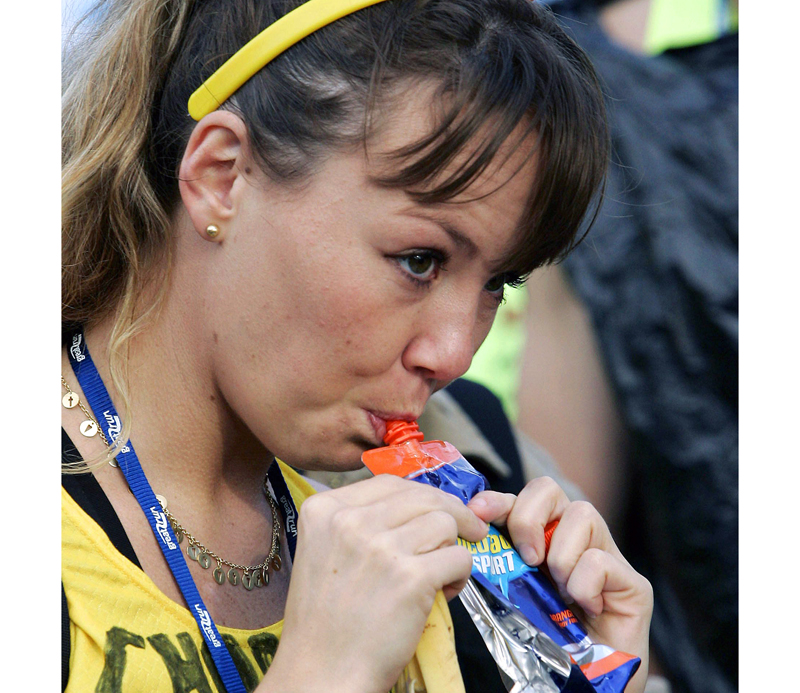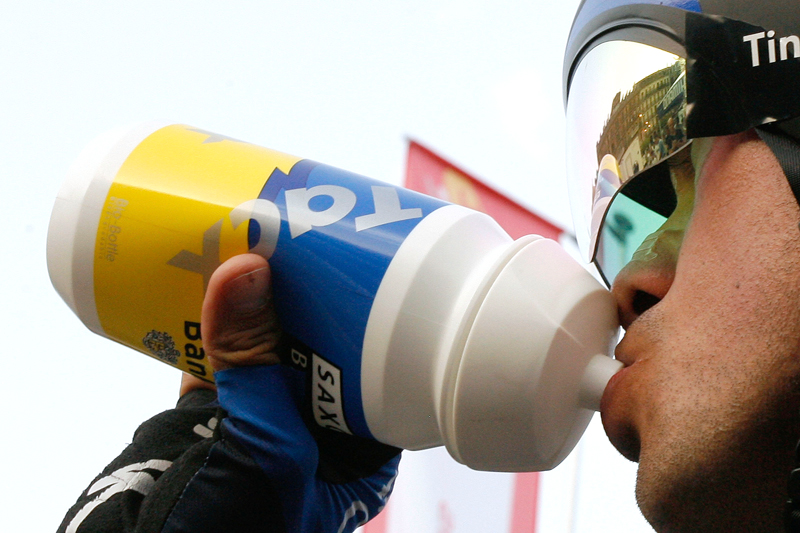Carbohydrate and endurance performance: revolution and evolution
After almost three decades of sport performance research, Andrew Hamilton looks at some of the key breakthroughs in carbohydrate nutrition and what they mean for endurance athletes
Assuming your diet is healthy and you’re drinking ample fluid, it’s no exaggeration to say that when it comes to endurance, your carbohydrate nutrition can make the difference between merely adequate and truly excellent performance. That’s because carbohydrate is your body’s 5-star fuel. Consuming the right amount of the right type of carbohydrate at the right time can dramatically extend your endurance and delay fatigue. In this article therefore, we’re going to take a look at how our understanding of carbohydrate nutrition has changed since Sports Performance Bulletin was first launched, and what this means for athletes seeking maximum performance.Carbohydrate revolution
Until the 1980s, the advice on offer to athletes was pretty basic. Indeed, many endurance athletes still believed that high-protein meals such as steak and eggs were ideal pre-race nutrition! In particular, the massive importance of carbohydrate for endurance performance wasn’t fully appreciated. However, in the late 80s, a trickle of studies on endurance performance began to demonstrate why carbohydrate is so importance for endurance performance. By the early 1990s, this trickle of carbohydrate research became a torrent. A true breakthrough in our understanding of the importance of carbohydrate had been made.The key finding was that consuming carbohydrate during exercise can help offset the effects of glycogen depletion by providing working muscles with another source of carbohydrate. In particular, scientists discovered thatSports Med 1992; 14: 27–42 Metabolism 1996; 45: 915–921 Am J Physiol Endocrinol Metab 1999; 276: E672–E683 Med Sci Sports Ex 1993; 25:4251 Int J Sports Med 1994; 15:122-125 Med Sci Sports Ex 1996; 28: i-vii J Athletic Training 2000; 35:212-214 Int J Sports Nutr 1997; 7:26-38 Nutrition Reviews 1996; 54: S136-S139:
- Carbohydrate taken during exercise can be oxidised at a rate of roughly 1 gram (g) per minute, supplying approximately 250kcals per hour).
- This carbohydrate can be supplied and absorbed well by drinking 600-1200mls of a solution of 4-8% (40-80g per litre of water) carbohydrate solution per hour.
- Ingested carbohydrate becomes the predominant source of carbohydrate energy late in a bout of prolonged exercise, and can delay the onset of fatigue during prolonged cycling and running as well as improving power output.
Two sugars please!
The 1990s carbohydrate studies on carbohydrate and endurance used glucose and/or glucose polymer drinks. However, while they produced significant performance improvements, these types of carbohydrate drinks (and gels) are only able to supply around 60g per hour (around 250kcals per hour), which provides no more than a modest replenishment of energy compared to that being expended during training or competition (elite athletes can burn well over 1000kcals per hour). That’s because taking higher amounts than 60g per hour invariably causes gastric distress – and the fact that the extra carbohydrate ingested is simply not absorbed or utilised.“In the late 80s, a trickle of studies on endurance performance began to demonstrate why carbohydrate is so important for endurance performance”
But around that time, Canadian scientists were experimenting with giving carbohydrate drinks containing mixtures of two different sugars (glucose and fructose) to cyclistsJ Appl Physiol. 1994; ss76(3):1014-9. In particular, they wanted to see how well these mixtures were absorbed during exercise and oxidised for energy in the body. The key finding was that when the cyclists drank a 50/50 glucose/fructose mix, the amount of the ingested carbohydrate that the cyclists were able to use for energy production increased by over a fifth. Then in 2004, a team from the University of Birmingham published a landmark studyJ Appl Physiol 2004; 96: 1277–1284. In this study, cyclists performed four exercise trials in random order while drinking one of the following drink formulations:
- 1.2 grams per minute of glucose (medium glucose);
- 1.8 grams per minute of glucose (high glucose);
- 1.2 grams per minute of glucose + 0.6 grams per minute of fructose (medium glucose/fructose blend);
- Water (control).
Graph: Glucose vs. Glucose + Fructose
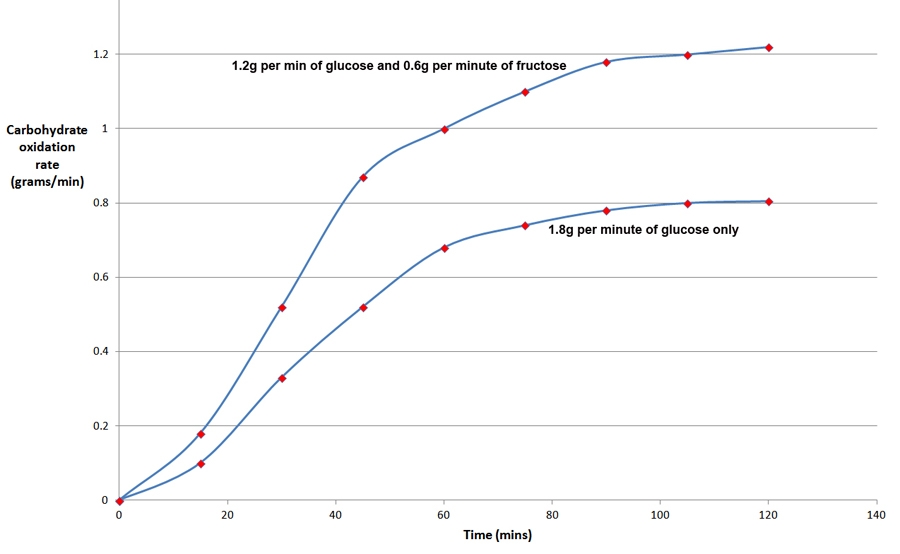
Box 1: Why does adding fructose to glucose enhance carbohydrate uptake?
When you consume a glucose-only carbohydrate drink, the glucose molecules in it can’t just ‘leak’ across the intestinal wall into the bloodstream. They have to be actively transported across by special proteins in the gut wall called ‘transporter-proteins’.Scientists have discovered that these glucose transporter proteins become saturated at a glucose ingestion rate of around 60g per hour. In other words, if you ingest glucose at a higher rate than this, all the transport sites are occupied and the surplus glucose molecules have to ‘queue up’ to await transportation.
However, fructose is absorbed from the intestine by a completely different type of transporter. So when additional carbohydrate is given as fructose, the extra fructose molecules don’t have to ‘queue up’. They have their own route across the intestine independent of glucose transporters and can be absorbed at 30g per hour. The net effect is that up to 90g per hour of carbohydrate in total finds its way into the bloodstream, which means that more is available to be burned by muscles to produce energy.
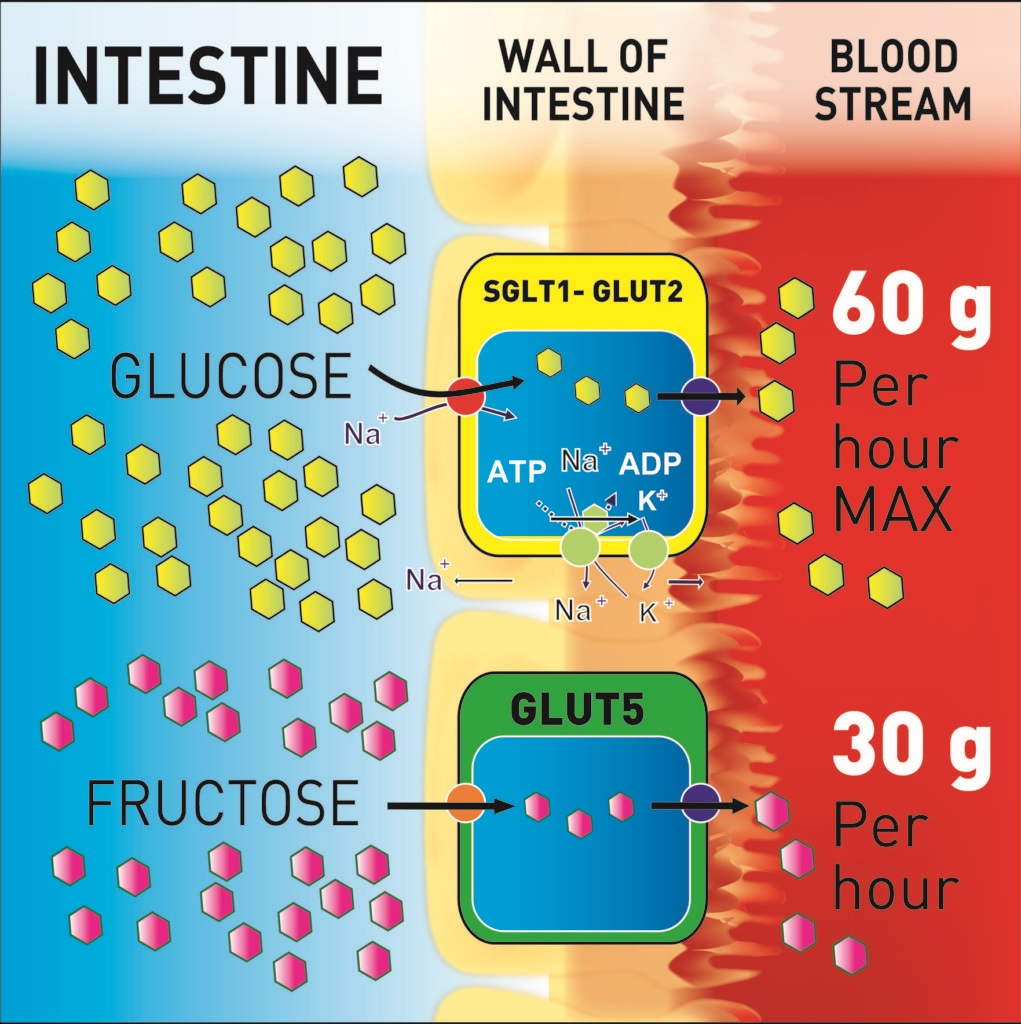
The study above and othersMed. Sci. Sports Exerc. 2004; Vol. 36, No. 9, pp. 1551–1558 showed that glucose/fructose mixtures – so called ‘multiple transportable carbohydrates’ do result in higher oxidation rates of ingested carbohydrate, especially in the later stages of exercise. Subsequent studies also showed that (compared to a glucose-only drink), 2:1 glucose/fructose drinks can result inJ Appl Physiol 2006; 100:807-816:
- More energy produced from consumed carbohydrate (in drink) and less from stored muscle carbohydrate, thereby preserving muscle glycogen stores;
- Better hydration due to increased amounts of water absorbed from the stomach;
- A reduced perception of stomach fullness after consuming the same volumes of drink;
- Lower perceived rates of exertion in the later stages of exercise.
Figure 1: Cycling performance with glucose or glucose + fructose ingestion
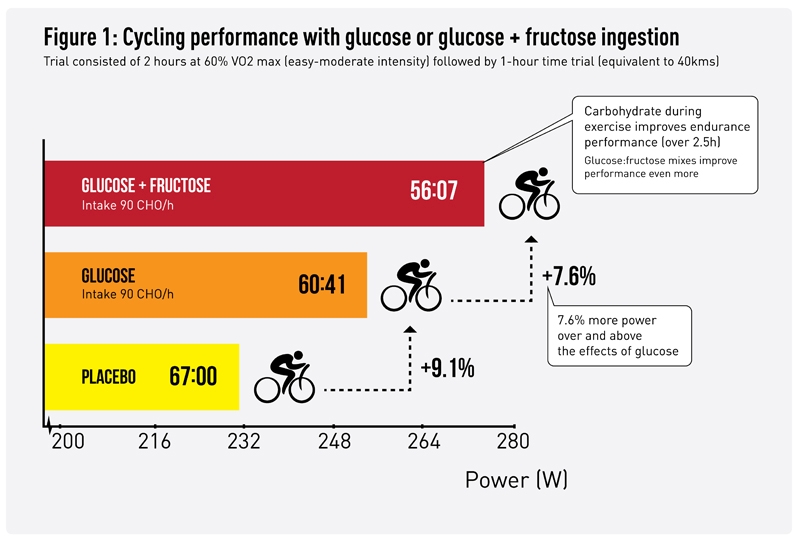
Spit or swallow?
How on earth could it be that simply swilling a carbohydrate drink around the mouth and then spitting it out can boost exercise performance? This question underlies another breakthrough in carbohydrate nutrition – so called carbohydrate rinsing, which we have recently reported in Sports Performance Bulletin. The theory (which has support from studies using a powerful brain scanning technique called fMRI) is that when you ‘carbohydrate rinse’, carbohydrate sensors in the mouth signal to the brain that food is on its way, thus reducing the perception of effort and making the exercise task easier. In effect, these receptors are telling the brain: “you have nothing to worry about, because energy is on its way!”In one of the key studies to confirm this effect, scientists asked cyclists to perform a 40km time trial. During the trial, subjects rinsed their mouth with carbohydrate drink for 5 seconds and then spat the drink out into a bowl – ie they were not allowed to swallow any of the drinkMed Sci Sports Exerc 36(12): 2107-11, 2004. The results were quite unexpected. Cycling performance was significantly improved; the cyclists were about one minute faster, even though none of the carbohydrate had actually entered their bodies (no carbohydrate is absorbed in the mouth). More recent research (reported here in Sports Performance Bulletin) has refined our knowledge on the best way to use carbohydrate rinsingInt J Sport Nutr Exerc Metab. 2013 Feb;23(1):48-56 Nutrients. 2013 Dec 19;6(1):1-10 Nutrients. 2016 Mar 9;8(3):49 Med Sci Sports Exerc. 2016 Sep;48(9):1810-20 Nutrients. 2016 May 9;8(5). pii: E269.; although it can offer benefits, there are a number of ifs, buts and maybes for its successful use (see box 2).
Current best thinking
Putting together the early carbohydrate research of the 80s and 90s together with more that of the ‘naughties’ (and even more recent findings), can we bring it all together and make general recommendations for endurance athletes seeking maximum performance? Figure 2 provides some overall guidelines based on our current best thinking. It’s important to understand however that because we’re all individuals and respond slightly differently to carbohydrate intake, a little bit of flexibility is required when applying these guidelines.Figure 2: Current best thinking for carbohydrate supplementation on the move
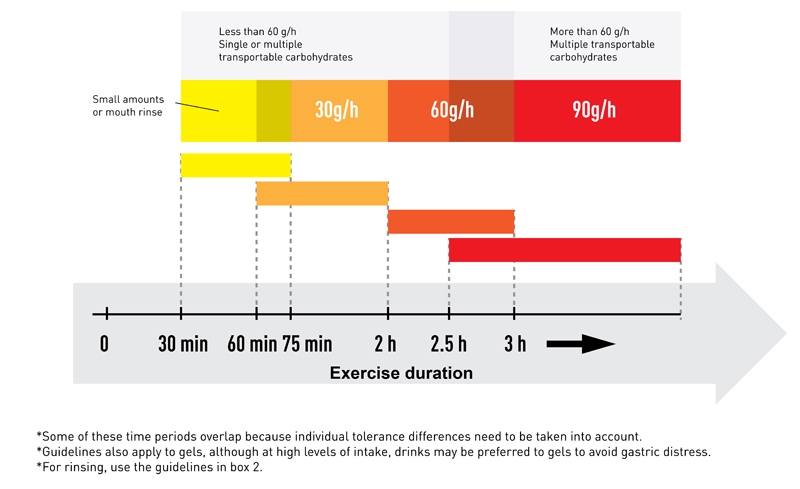
Box 2: Practical guidelines for carbohydrate rinsing
Can carbohydrate rinsing really help your performance and if so, when and how should you use it? On the weight of the current evidence, our recommendations are as follows:- For most athletes in most situations, carbohydrate rinsing doesn’t offer any real advantages over consuming drinks (or gels).
- The exception could be during longer events when you’re already carbohydrate depleted. In this situation, carbohydrate rinsing could be valuable, especially if you have a sensitive tummy and/or you’re suffering from gastric distress.
- Another instance is where your carbohydrate drink is running low and you need to eek it out. Regular rinsing over an extended period could be more effective than gulping what you have left down in one go - then hanging on!
- If you want to try carbohydrate rinsing, your mouth should be rinsed with a carbohydrate solution every 10 minutes or so.
- A lollypop or a sweet can also be used but care should be taken to ensure you don’t swallow or choke on it!
- Carbohydrate drinks used for rinsing should be at 10-20% concentration (10-20 grams per 100ml).
The gel revolution
No look back at carbohydrate supplementation would be complete without discussing gels. As popular as carbohydrate drinks are, they don’t tick all of the boxes all of the time. For starters, there’s the faffing around and potential mess of mixing them up before you set off. Then there’s the logistics; water is heavy stuff, and lugging enough carbohydrate drink to fuel a long event is no fun if the race feeding stations only offer water. Perhaps most importantly of all, a lot of athletes find that there’s only so much fluid you can drink for energy without craving something a bit more concentrated – especially in cooler conditions.Enter the energy gel, which addressed both of these issues at a stroke. The first gels appeared on the market in the late 80s; for example, at the 1988 Hawaiian Ironman Triathlon, Leppin’s ‘Squeezy’ gels (co-developed by running guru Professor Tim Noakes) were distributed to competitors. In the years after their introduction however, gels remained something of a cult product - probably down to the fact that many of the early gel products tasted vile! But over the past 15 years or so, better formulations and manufacturing technology has produced gel products with great taste and texture – hence the explosion in the popularity of gels in recent years.
Like carbohydrate drinks, gels provide readily and easily absorbed carbohydrate, often with electrolyte minerals too. But because they contain far less water, the carbohydrate in gels is more concentrated and portable. To illustrate this, consider that just 3 gel sachets weighing around 100g in total (and which can easily be slipped in a back pocket or money belt) will likely contain as much carbohydrate as 1kg of carbohydrate drink!
The downside of course is that if you rely on gels for energy replacement, you still need to think about topping up your water/fluid intake, especially in warmer conditions, when sweat losses will add to your fluid replacement needs. Although there’s quite a degree of flexibility in terms of how much water is consumed and when, the ideal solution (no pun intended) is for athletes to consume enough water to produce a reasonable dilution in the gut.
Gel downsides
Another key consideration with gels is that how they are tolerated seems to vary considerably from person to person. A 2009 study (reported by Sports Performance Bulletin) looked at the gastrointestinal (GI) tolerance of highcarbohydrate intakes (up to 84 grams per hour) using gels, during intense running in 34 endurance runnersInt J Sport Nutr Exerc Metab. 2009 Oct;19(5):485-503. It found that although quite well tolerated by most, around 10-20% of the runners experienced serious GI problems, and that for these athletes, feeding strategies relying on drinks rather than gels might be required.Support for this approach came from a very recent study suggesting that for those with sensitive stomachs, the old-fashioned energy drink could still be preferableInt J Sport Nutr Exerc Metab. 2016 Apr;26(2):114-22. Using nine triathletes as test subjects, researchers investigated performance differences between using carbohydrate energy drinks or gels. Each triathlete completed two ‘laboratory triathlons’ consisting of a 60-minute swim, a 180-minute bike ride and a 60-minute all-out run. In one of the trials, the triathletes consumed 67 grams per hour of carbohydrate in the form of a carbohydrate drink. In the other, they consumed exactly the same amount of the same type of carbohydrate from gels. Importantly the amount of fluid provided was matched in each trial – ie extra water was given to the triathletes during the gel trial ensure the total fluid intake was identical in both trials.
Figure 3: Scott Molina

Although the triathletes’ performances during the flat-out run were the same regardless of which energy product they used, when it came to comfort, 7 out of the 9 triathletes reported gastrointestinal discomfort (tummy cramps, bloating etc) when using gels. In contrast, not one of the triathletes experience tummy problems when consuming the carbohydrate drink (see figure 4)! Given that carbohydrate drinks are in essence a diluted form of gel, these are surprising results. One possible explanation is that whereas carbohydrate drink provides a constant concentration of carbohydrate when consumed, consuming gels plus water can result in different (and at times higher) carbohydrate concentrations, depending on the timing of water consumption.
Figure 4: Carbohydrate drink vs. Gel and gastric distress

Box 3: Practical guidance for gel use
Here are some tips based on these findings and best practice on gel use generally:- If you have a particularly sensitive tummy, you might find it best to rely on carbohydrate drinks rather than gels for energy replacement.
- If you like using gels however, try experimenting with different brands and types; you may find a lower-osmolality gel, which is easier on the tummy.
- At very high rates of carbohydrate intake (above 80g per hour) carbohydrate drinks may be easier on the tummy than gels regardless of whether you have a sensitive tummy.
- For every 20g of gel carbohydrate consumed (the average content per sachet), aim to consume around 250mls of water.
- If you take gels topped up with plain water, try to consume water with your gels rather than at random times in between gels.
- If you consume all your carbohydrate in gel form, top up with plain water rather than carbohydrate drink (which would supply surplus carbohydrate).
- Like caffeinated carbohydrate drinks, gels containing caffeine are best used sparingly and towards the later stages of a longer event when the fatigue-fighting properties of caffeine are most needed.
You need to be logged in to continue reading.
Please register for limited access or take a 30-day risk-free trial of Sports Performance Bulletin to experience the full benefits of a subscription. TAKE A RISK-FREE TRIAL
TAKE A RISK-FREE TRIAL
Newsletter Sign Up
Testimonials
Dr. Alexandra Fandetti-Robin, Back & Body Chiropractic
Elspeth Cowell MSCh DpodM SRCh HCPC reg
William Hunter, Nuffield Health
Newsletter Sign Up
Coaches Testimonials
Dr. Alexandra Fandetti-Robin, Back & Body Chiropractic
Elspeth Cowell MSCh DpodM SRCh HCPC reg
William Hunter, Nuffield Health
Keep up with latest sports science research and apply it to maximize performance
Today you have the chance to join a group of athletes, and sports coaches/trainers who all have something special in common...
They use the latest research to improve performance for themselves and their clients - both athletes and sports teams - with help from global specialists in the fields of sports science, sports medicine and sports psychology.
They do this by reading Sports Performance Bulletin, an easy-to-digest but serious-minded journal dedicated to high performance sports. SPB offers a wealth of information and insight into the latest research, in an easily-accessible and understood format, along with a wealth of practical recommendations.
*includes 3 coaching manuals
Get Inspired
All the latest techniques and approaches
Sports Performance Bulletin helps dedicated endurance athletes improve their performance. Sense-checking the latest sports science research, and sourcing evidence and case studies to support findings, Sports Performance Bulletin turns proven insights into easily digestible practical advice. Supporting athletes, coaches and professionals who wish to ensure their guidance and programmes are kept right up to date and based on credible science.





